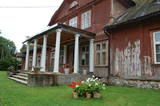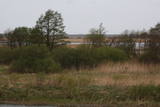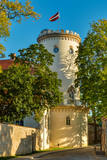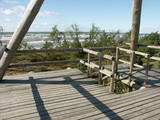| Нo | Название | Описание |
|---|---|---|
|
Находится в 50 м к западу от Лудзенской католической церкви. Построена в 1738 году в форме восьмиугольной ротонды и служила местом отдыха графов Карницких. Небольшое здание с дощатой обшивкой, деревянным потолком и кирпичным полом. Возле капеллы установлена скульптура Девы Марии (1934 г.) работы лудзенского художника Леона Томашицкого - королевы земли Мары. |
||
|
Mākoņkalna pagasta "Itkaču mājās" ir iespēja ieturēt maltīti- plānās pankūkas ar dažādiem pildījumiem, kartupeļu pankūkas, dārzeņu sautējumu. Iespēja apciemot trušus, pabarot tos ,paglāstīt un paturēt sev klēpī. Pieejami saimnieku veidoti suvenīri. |
||
|
Уютный ресторан, повара которого черпают вдохновение в местном растительном и животном царстве, предлагая посетителям насладиться забытыми вкусами в любое время года. Почетное место здесь занимают как местные блюда, так и продукты от лучших мировых мастеров. Великолепное сочетание разных вкусов и вина делает Umb Roht рестораном, в котором можно отправиться в самые разнообразные вкусовые путешествия. |
||
|
Музей расположен в здании мызы Ууэ-Варбла. Экспозиция отражает местный уклад жизни в первой половине прошлого столетия и историю волости Варбла. В музее есть и мастерская. В зерновом амбаре мызы Вы сможете познакомиться со старинными ручными инструментами и машинами. Особой достопримечательностью является возведённое в 1797 году основное деревянное здание мызы в стиле раннего классицизма.Традиционным мероприятием является организуемая в июле ярмарка ремесел. |
||
|
Расположен в старом здании школы, ул. Сколас, д. 11А. В музее представлены гостиная и кухня суйтов, литургические костюмы католических священников, меняющаяся экспозиция в выставочном зале и история формирования и нынешние дни этнографического ансамбля «Суйту сиевас» (“Suitu sievas”). Специальное предложение музея - выступления суйтских жен, суйтских мужей и суйтских дудочников. |
||
|
Один из крупнейших замков Курземе, сохранившийся до наших дней в сравнительно хорошем состоянии. В середине XIII века Рижский домский капитул приступил к строительству замка.В 1434 году Дундагское поместье купил епископ Курляндии. В период с XVI –XX вв. здесь хозяйничали представители рода Майделов и Остен-Сакен.Дундагский замок дважды сгорал и многократно перестраивался. Последний раз замок перестраивался после сожжения в 1905 году. Интерес представляют две стелы из песчаника по обе стороны входных дверей с фигурными рельефами рыцаря (с левой стороны) и епископа (с правой стороны). Замок известен легендами о свадьбе гномов и Зеленой деве. Сегодня в замке находится Дундагская музыкальная и художественная школа, гостиница и зал для торжеств, Дундагский ТИЦ и представлены разные экспозиции. Осмотр замка рекомендуется в сопровождении местного гида. Замок окружает парк, истоки которого относятся к XVII веку. Через парк течет речушка Паце, запруда на которой образует Дундагский пруд. С искусственного острова в пруду видно городище Калнадарзс. В парке по-прежнему зеленеет (некоторые большие ветки обломались) так называемый «Рублёвый дуб», изображение которого находилось на выпущенном в 1919 году денежном знаке – латвийские сто рублей. |
||
|
Маршрут предусмотрен для любителей активных пеших походов, которые хотят путешествовать по самой мощной речной долине Балтии, осматривая и ощущая. Маршрут начинается в Сигулде, которую с давних пор называют «Видземской Швейцарией». В окрестностях Сигулды открываются одни из красивейших видов в Латвии. Маршрут пересекает глубокие овраги многих притоков Гауи и открывает берега реки, которые в масштабах Балтии известны мощными обнажениями песчаника девонского периода. Природные тропы Лигатне – это единственное место в Латвии, где в условиях, максимально приближенных к естественной жизни в природе – в широких вольерах – можно увидеть живущих в латвийских лесах диких животных. Правда животных и следы их деятельности можно увидеть и в дикой природе, отправляясь по лесам и тропам национального парка «Гауя». Maršruta informācija no Latvijas Lauku foruma |
||
|
In the centre of Līgatne, on the right bank on the rapid Līgatne River, there is a viewing plan which offers a close-up look at one of the most impressive sandstone cliffs which rise above it – the Lustūzis cliff. There are artificial caves in the wall of the cliff, which locals use as cellars and as places to store their property.
|
||
|
Находится в Этнографическом музее Латвии под открытым небом. Обустроена висторической корчме, которая из Вецумниеки перевезена в музей, сохранив сквозной вертикальный дымоход над очагом (апвалкдуменис), печь для выпечки хлеба и др. Питание можно объединить с участием в коллективе народной музыки и ремесленничества. Организуют «Латышскую свадьбу». Латышская кухня: Бутерброды с килькой, минога, фаршированная щука, луковый клопс, бычьи яйца в сметанном соусе, приготовленный на гриле поросенок, деревенский хлеб, испеченный самими деревенский хлеб, на костре сваренный суп, блины. Особое блюдо: Жаркое в брусничном соусе от корчмы «Приедес крогс». |
||
|
Rokdarbniece Vineta Meistere piedāvā apskatīt, pasūtīt un nopirkt gleznas, dienasgrāmatas un recepšu grāmatas, kas izšūtas krustdūriena tehnikā. |
||
|
At the end of a wooden footpath in the Planči swamp is a viewing area and place for leisure. This is the place where you can enjoy landscapes of the high-type swamp and breathe the unusual air of the swamp. This is the only outdoor infrastructure object in Latvia with information posted in Braille. It is in the ZBR.
|
||
|
At the centre of this restricted area is the eutrophic Lake Tosmare, a former lagoon from the Littorina Sea. The lake and its surroundings offer protection to many plants and birds. At the southern end of the lake one can spot remnants of the former Liepāja fortification system, and to the West is one of the most important parts of that system – the Fortress canal. |
||
|
Одна из наиболее высоких дюн нашего побережья. В советское время в дюне велись копательные работы, так как песок использовался для производства силикатного кирпича. В 80-е годы ХХ века копательные работы были прекращены. Самая высокая часть дюны (хороший вид) сохранилась и поросла сосновым лесом. Создана природная тропа горы Пусену. Находятся в Бернатском природном парке. |
||
|
Das heute gesehene Ensemble (im Stil des Neorenaissance gebautes Gutshaus) entstand im wesentlichen in der Zeit zwischen 1897 – 1902 als ein Eigentum vom Grafen Joseph Tyszkiewicz und seiner Frau. Ein Park. |
||
|
Хотя географически Цесис находится в центральной части национального парка Гауи, у города нет статуса национального парка. Однако в Цесисе есть много интересных достопримечательностей, которые стоит увидеть и узнать поближе. Обязательно нужно ознакомиться со старым городом Цесиса. Цесис. Истоки Цесиса нужно искать здесь, на 18-метровой горе Риексту, так как в 11 – 13 веках здесь находился деревянный замок вендов. Гора Риексту находится в центре замкового парка, и с нее открывается прекрасный вид на парк, пруд и развалины Цесиса, до которых можно дойти по длинному каскаду лестниц. Построенный в начале 13 века Цесисский замок (описание см. далее в № 44) был резиденцией магистров ордена и одной из самых сильных крепостей ордена на территории Балтии. Рядом с крепостью находится Новый замок Цесис, который построен в 1777 году на месте укрепления ворот. В здании расположен Музей истории и искусств Цесиса, а в пристройке замкового комплекса разместился Центр для посетителей и Туристический информационный центр. Если поднимемся на башню замка, с нее откроется прекрасный вид на развалины, лютеранский собор Св.Иоанна и северную часть города. Напротив Нового замка находится несколько зданий – конюшня дворцовой усадьбы, каретный двор (оба здания построены в первой половине 19 века), где сегодня находится Цесисский выставочный центр. На территории комплекса с наружной стороны дворца можно осмотреть также амбар, домик извозчика и старую пивоварню. На противоположной стороне улицы находится романтичный парк Мая, который был разбит в тридцатые годы 19 века. Направимся дальше по улицам города (Большая Екатерининская, Малая Екатерининская, Малая Калею, Калею, Большая улица Ливов и Площадь Ливов) и осмотрим деревянную застройку, произведенную на рубеже 18 – 19 веков. На улице Торня (Башенной), которая вьется вдоль крепостной стены Средневекового замка, у церкви находится скульптура М. Янсона «На протяжении веков». Поверье гласит, что потерев фонарь Старика Времени, можно заглянуть в будущее. Одно из наиболее впечатляющих зданий Цесиса - Лютеранский храм Св.Иоанна, построенный в конце 13 века как Храм Ливонского ордена. Это трехнефная базилика в романском стиле с элементами готики, с возведенной в 1853 году 65-метровой башней. Здание было несколько раз перестроено, в том числе и в 20 веке. В храме выставлены надгробные плиты магистров Ливонского ордена и Ливонских епископов, Кафедра изготовлена в 1748 году, дубовый алтарь – в 1858 году, а алтарная картина «Распятый на кресте» - в 1862. Окна алтарной части церкви украшают художественно ценные витражи. Орган был построен фирмой Е. Ф. Валкера в 1907 году, и он является одним из лучших латвийских концертных инструментов. В сваю юго-западного угла церкви вмурованы солнечные часы с годовым числом «1744». Стоит подняться на смотровую башню церкви. У подножия церкви находится Площадь Роз или бывшая Рыночная площадь (середина 13 века – 1927 год, восстановлена в 2008 году), которая в наши дни является центральной площадью города. В средние века здесь находился также позорный столб и городской колодец. Рижская улица с самого начала образования города формировалась как главная улица. Здесь располагается большая часть архитектурно значимых строений 18 -19 века – бывшая Цесиская ратуша, дом Фабера, дом Принцесс. На одном конце улицы находится площадь Ливов, где в 13 веке находилась церковь, кладбище и Рижские ворота в городской стене. Сегодня площадь украшает светящийся фонтан, на месте которого находился колодец 13 века – Леяс Шкимбегс. На другом конце улицы находится реконструированная часть фундамента и фрагментов надземной части ворот Раунас городской стены 14 - 15 века. Она дает хорошее представление о средневековой стене, размере ворот и ее основательности. |
||
|
The Grey Dune of Pāvilosta nature reserve covers 42 hectares of land and has been designated to protect Latvia’s widest dune (1.5 km parallel the seacoast, and 812m in the direction from the sea to inland) and the biotopes and species found there. A two-storied watching platform is built to savour the scenery. In Soviet time, local fishermen used to dry seaweed in dunes for production of agar, and thus rich vegetation developed in the dune. The Gray Dune is part of a unique landscape with the sea view, the traditional architecture of Pāvilosta fishing town, and biotopes, including protected, which border the nature reserve: pine forest, embryonic dunes, white dunes, and wet beech where once can find springs. Biotope 2130, “Fixed dunes with herbaceous vegetation (grey dunes)” is found here. At present, pines are taking over the biotope, therefore some maintenance activities are required. The Grey Dune is most beautiful in the second half of July and in August when the blossoming Breckland Thyme (Thymus serpyllum) and Narrowleaf Hawkweed (Hieracium umbellatum) colour the dune in shades of yellow and violet. The most typical species here are Pasqueflower (Pulsatilla pretense), Grey Hair-grass(Corynephorus canescens), Blue Hair Grass (Koeleria glauca), Sand Pink (Dianthus arenarius). The Gray Dune earned wide recognition when a group of enthusiasts actively campaigned for six years to achieve the status of the nature reserve. Guna Grimsta, a group representative remembers that they organised events and activities throughout Latvia involving large part of the society, prominent personalities, church parishes, NGOs, school youth and university students. The activists were writing letters, making videos, doing research articles, composing music, collecting signatures and submitting proposals to achieve official status of the Grey Dune as an especially protected nature site. They organised seminars, concerts, art plenaires and exhibitions, educational excursions, joint-work, musical church services, meetings with high officials and their on-site visits to the Gray Dune. In 2006 the group received the title „Proudness of Latvia” awarded by the national TV3 broadcasting company and daily paper „Diena”. |
||
|
Гончары занимаются как традиционным гончарным делом различных эпох, так и пытаются познать старинные формы, материалы и методы, которыми пользовались наши предки в предыдущие столетия. Экскурсия, осмотр печи, работа с глиной, приобретение керамических работ, осмотр коллекции старинных орудий труда и керамики. Приглашают на открытие печи. |
||
|
Историческая дорога (V1279), которая до строительства новой дороги через Эдоле соединяла Кулдигу с Алсунгой. В настоящее время живописная дорога (с гравийным покрытием) вьется через леса и сельскохозяйственные угодья. В подходящее время ее можно использовать как альтернативную дорогу, чтобы познакомиться с ландшафтами региона суйтов. По Старой дороге суйтов можно путешествовать на велосипеде. |
||
|
This ancient river valley stretches from Koorvere to the Otteni Windmill, and there are nearly 40 revealed sandstone cliffs from the Devonian age. Two of them, Väike and Suur Taevaskoja (the latter is 22 m high) are popular tourist destinations.
|
||
|
38-метровая башня стены Овишского маяка (сигнальный фонарь расположен на высоте 33 метров) построена в 1814 году и без особых изменений функционирует до сегодняшнего дня. Это самый старый действующий маяк Латвии, в котором размещена экспозиция, посвященная Латвийским маякам. |
||























